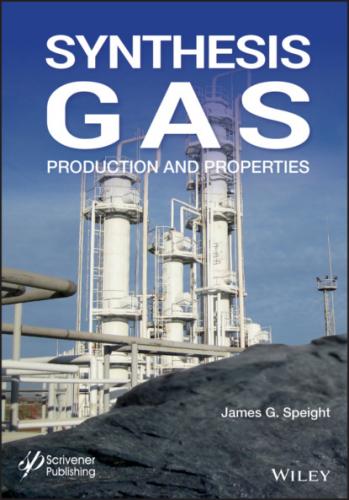Synthesis Gas. James G. Speight
Oxford, United Kingdom.
72 Speight, 2013f. Shale Gas Production Processes. Gulf Professional Publishing, Elsevier, Oxford, United Kingdom.
73 Speight, J.G. 2014a. The Chemistry and Technology of Petroleum 5th Edition. CRC Press, Taylor & Francis Group, Boca Raton, Florida.
74 Speight, J.G. 2014b. The Gasification of Unconventional Feedstocks. Gulf Professional Publishing, Elsevier, Oxford, United Kingdom.
75 Speight, J.G. 2014c. High Acid Crudes. Gulf Professional Publishing, Elsevier, Oxford, United Kingdom.
76 Speight, J.G. 2015a. Handbook of Hydraulic Fracturing. John Wiley & Sons Inc., Hoboken, New Jersey.
77 Speight, J.G. 2015b. Offshore Oil and Gas. Gulf Professional Publishing, Elsevier, Oxford, United Kingdom.
78 Speight, J.G. 2016. Introduction to Enhanced Recovery Methods for Heavy Oil and Tar Sands 2nd Edition. Gulf Professional Publishing Company, Elsevier, Oxford, United Kingdom.
79 Speight, J.G., and Islam, M.R. 2016. Peak Energy – Myth or Reality. Scrivener Publishing, Beverly, Massachusetts.
80 Speight, J.G. 2017. Handbook of Petroleum Refining. CRC Press, Taylor & Francis Group, Boca Raton, Florida.
81 Speight, J.G. 2019a. Handbook of Petrochemical Processes. CRC Press, Taylor & Francis Group, Boca Raton, Florida.
82 Speight, J.G. 2019b. Natural Gas: A Basic Handbook 2nd Edition. Gulf Publishing Company, Elsevier, Cambridge, Massachusetts.
83 Speight, J.G. 2020. Shale Gas and Shale Oil Production Processes, Elsevier Inc., Cambridge, Massachusetts.
84 US Congress. 1976. Public Law FEA-76-4. United States Library of Congress, Washington, DC.
85 Wihbey, P.M. 2009. The Rise of the New Oil Order: The Facts behind the New Massive Supplies, the Exciting New Technologies, and the Emerging Powers of the XXIst Century. Academy & Finance SA, Geneva, Switzerland.
86 World Energy Council. 2008. World Energy Outlook: Global Trends to 2030. International Energy Agency, Paris, France.
87 Wright, L., Boundy, R, Perlack, R., Davis, S., and Saulsbury. B. 2006. Biomass Energy Data Book: Edition 1. Office of Planning, Budget and Analysis, Energy Efficiency and Renewable Energy, United States Department of Energy. Contract No. DE-AC05-00OR22725. Oak Ridge National Laboratory, Oak Ridge, Tennessee.
88 Yergin, Y. 1991. The Prize: The Epic Quest for Oil, Money and Power. Free Press, New York.
89 Yergin, D. 2011. The Quest: Energy Security and the Making of the Modern World. Penguin Press HC, New York.
90 Yeung, T.W. 2014. Evaluating Opportunity Crude Processing. Digital Refining. http://www.digitalrefining.com/article/1000644; accessed October 25, 2014.
91 Zatzman, G.M. 2012. Sustainable Resource Development. Scrivener Publishing LLC, Beverly, Massachusetts.
2 Production of Synthesis Gas
2.1 Introduction
Synthesis gas (also frequently referred to by the abbreviated name syngas) is a fuel gas consisting primarily of carbon monoxide and hydrogen with, on occasion depending upon the feedstock and the production process, a smaller amount of carbon dioxide. Synthesis gas has been, for decades, a product of coal gasification and the main application has been, and continues to be, the generation of electricity.
In addition to coal as the (formerly) primary feedstock, synthesis gas can be produced from many sources, including natural gas, coal, biomass, or virtually any hydrocarbon feedstock, by reaction with steam (the steam reforming process), with carbon dioxide (the dry reforming process), or with oxygen (the partial oxidation process). Synthesis gas has become a crucial intermediate resource for production of hydrogen, ammonia, methanol, and synthetic hydrocarbon fuels. It is also used as an intermediate in the production of (i) synthetic crude oil, (ii) hydrocarbon fuels and lubricants by way of the Fischer-Tropsch process, and (iii) the methanol-to-gasoline process. In each case, the production methods include (i) steam refoming of natural gas or liquid hydrocarbon derivatives to produce hydrogen and (ii) the gasification of carbonaceous feedstocks such as coal (Chapter 4), crude oil resid (Chapter 5), biomass (Chapter 6), and waste (Chapter 7).
The gasification process is a process that converts organic (carbonaceous) feedstocks into carbon monoxide, carbon dioxide and hydrogen by reacting the feedstock at high temperatures (>700°C, 1290oF), without combustion, with a controlled amount of oxygen and/or steam (Lee et al., 2007; Speight, 2008, 2013). The resulting gas mixture (synthesis gas, also commonly referred to as syngas) – which is a mixture of carbon monoxide, CO, and hydrogen H2 – is itself a fuel as well as a source of a wide variety of chemicals (Table 2.1).
The power derived from carbonaceous feedstocks and gasification followed by the combustion of the product gas(es) is considered to be a source of renewable energy if the derived gaseous products are generated from a source (e.g., biomass) other than a fossil fuel (Speight, 2008). The gasification of a carbonaceous feedstock or a derivative (i.e., char produced from the carbonaceous material) is the conversion of a carbonaceous feedstock, such as coal, by any one of a variety of processes to produce gaseous products that are combustible or can be used for the production of a range of chemicals (Figure 2.1).
The advantage of gasification is that the use of synthesis gas is potentially more efficient as compared to direct combustion of the original fuel because it can be (i) combusted at higher temperatures, (ii) used in fuel cells, (iii) used to produce methanol and hydrogen, (iv) converted via the Fischer-Tropsch process into a range of synthesis liquid fuels suitable for use in gasoline engines or diesel engines. The gasification process can also utilize carbonaceous feedstocks which would otherwise have been disposed of (e.g., biodegradable waste). In addition, the high-temperature process causes corrosive ash elements including metal chlorides and potassium salts which allow clean gas production from otherwise problematic fuels.
Table 2.1 Example of chemicals produced from synthesis gas.
| Synthesis gas | Fuel gas | |||
| Town gas | ||||
| Hydrogen | Ammonia | |||
| Urea | ||||
| Fischer-Tropsch liquids | Synthetic natural gas | |||
| Naphtha | ||||
| Kerosene | ||||
|
|
